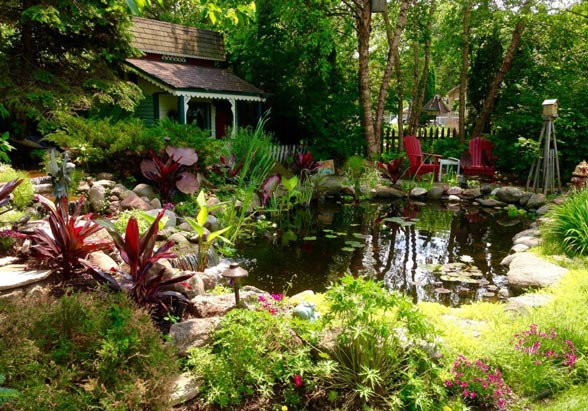Most of us, the garden is a great place to relax, throw the odd barbecue or perhaps cultivate some nice plants or fresh vegetables if you have a large enough space. It’s also the perfect place to attract local wildlife and help save some species such as bees, bats, and butterflies currently under threat.
Especially if you live in a highly urbanized area, your garden area offers a brilliant opportunity to bring some of the countrysides to your very own doorstep.
Helping the Pollinators
Pollinators basically go from plant to plant, feeding on nectar and performing the valuable job of collecting pollen on their bodies and transferring it to other plants. It’s what helps keep the horticultural world spinning, and without these bees, insects, birds, and butterflies, we’d live in a pretty barren world. In particular, Bees have been in short supply in some areas of North America and the rest of the globe recently, largely because of loss of habitat and the overuse of pesticides.
We don’t suggest that you set up your own honey making business but putting in a few plants that attract the right kinds of insects can make all the difference.
Plant Native Species
Plant types vary considerably across the US. After all, it’s a pretty big country. Growing species that are not native to the area you live in might seem a harmless enough thing to do, but it can have big consequences for the local wildlife. Most of the good advice nowadays is to plant only native species in your garden as these are the ones that local pollinators have evolved to rely upon.
You can use a website like the Pollinator Partnership to guide each US area’s right plants if you are unsure what you should be choosing.
Invest in a Compost Heap
Incorporating a into your garden can help you maintain the soil with little overall cost and is a simple way to reduce your carbon footprint. It means you don’t have to worry about going out to buy expensive and possibly harmful fertilizers or manufactured composts because you have your own. It gives you the chance to break down unwanted food and garden waste that would otherwise be thrown away.
Avoid Harmful Pesticides
It might seem like the right solution to use pesticides in your garden, but they can cause all sorts of harm not only to the local wildlife but also to the surrounding human population. Controlling an insect or vermin problem can be a tricky business, but there are plenty of non-invasive ways to do it if you take the time to look for the right solution.
For instance, you can lure harmful creatures away with trap plants, the ones they prefer to feed on, by planting them nearby the ones you are trying to protect. If you have trouble with pests such as slugs in your wildlife garden, then attracting more animals such as hedgehogs and birds into the area can solve the problem.
Being armed with more knowledge and doing your research is also a good way to make sure that you don’t make mistakes. There are plenty of beneficial insects in your garden that shouldn’t be harmed, and you can even buy some of these by mail order to protect different plants.
Feed the Birds
From the dark-eyed junco and the tufted titmouse to the Carolina wren and the ubiquitous robin, there are a wide variety of garden birds North America has to offer. Setting up a few feeders here and there can attract some wonderful and colorful wildlife into your garden, and if you maintain supplies, the birds will keep on coming back for more.
Much is going to depend on what feed you put out and where you put it. There are ground feeders who love to hop around on the grass, as well as those that like the cover of some well-placed bushes to make sure they are protected from predators while they nibble away. Some birds prefer small dark Niger seeds while others have a hankering for sunflower husks or even peanuts.
Birds can help keep those nasty bugs that can decimate your plants during the summer months away. Put up some nesting boxes and provide a decent water source, and you could have a natural and attractive bug control plan in place in no time.
Provide Cover
If you want to attract plenty of wildlife, you need to provide plenty of cover areas. Putting some rotting logs in a corner can help cultivate all manner of worms and bugs that birds and other animals can feed on. If you want to attract reptiles such as frogs and toads, building in a pond if you have enough room is also a great idea. Most state government websites will include plenty of advice on how best to attract different and often endangered species to your garden.
Wider Benefits of a Wildlife Garden
Developing your own natural wildlife garden, whether you live in the city or out in a town, is a great idea and benefits the environment and helps keep the air clean and promote good health.
It’s excellent for the brain, too, as there’s nothing better than watching birds scoot in and out of the bushes and trees or butterflies and bees flying from plant to plant on a summer’s day. Even in winter in the northern states, putting out those bird feeders can make sure that your garden is full of life and vitality.
All this will also give you access to natural pest control, as the birds will eat insects and the food you put out, and animals such as hedgehogs and frogs will keep the slug population down. And if you have children, a wild garden can be a brilliant place to learn about animals as well as giving the kids many hours of fun.
If you have to resist any questions, please contact us!

About the Author
Jen is your go-to guru for crafting a cozy, green cocoon. 🪴 Her dive into sustainable building wasn’t just about saving the planet—it started as a mission to make family movie nights eco-friendly (and to ensure the popcorn was the only thing getting heated!). With a knack for breaking down the jargon, Jen turns eco-lingo into everyday language. Swing by the Green Living blog for a mix of earth-loving advice and home improvement hacks. Whether you’re just dipping your toes into green waters or you’ve been swimming in the deep end of DIY projects, Jen’s here to guide, giggle, and remind you that every eco-choice is a step towards a planet that thanks you… and maybe even sends a rainbow your way! 🌈


